Related Topics
LIVING WITH BEARS IN BLACK BEAR COUNTRY
On Saturday June 16th, 2001, Craig Todd of the Bruce County Stewardship Association and the Ministry of Natural Resources held a public information meeting at the Northern Bruce Peninsula meeting hall on Living With Black Bears in Black Bear Country. This workshop was well attended and much positive information was made available.
This workshop was well attended and much positive information was made available.
Many publications, pamphlets and material are available through the Ministry of Natural Resources.
Contact Kathy Dodge at the Owen Sound Area Office:
1450 - 7th Avenue East
Owen Sound, Ontario, N4K 2Z1
Phone: (519) 376-3860 / Fax: (519) 372-3305
Internet web site: Ministry Of Natural Resources - Ontario
You can view and download the MNR's brochure, BEAR WISE, right here: Bear Wise
Here are some web links discussing Black Bears:
How Dangerous Are Black Bears Can we Coexist?
Bear Country Safety Safety Tips of Do' & Don'ts
Bad Bears? Tips when meeting bears
Black Bear Facts The Bears Life
North American Bear Center Everything you wanted to know about bears.
Defenders of Wildlife Bears
TO REPORT BEAR PROBLEMS: contact the MNR'S Bear Reporting Line at:
1-866-514-BEAR (2327) (TTY) 705 945-7641
(Photo from MNR Web site)
EASTERN MASSASAUGA RATTLER
The Eastern Massasauga Rattler is a threatened species, protected by both Provincial and Federal law. It is illegal to kill a Massasauga Rattler.
That being said, most people will NEVER get to see one. They are non-aggressive and avoid human contact. They rely on coloration and staying still to remain hidden. If someone comes too close, they will rattle. Biting is the last resort. 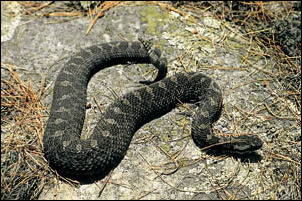
The massasauga's striking distant is very short - half its body length. Their fangs are small and cannot penetrate leather hiking-boots, and barely penetrates loose clothing. If a bite does occur, 25% of the time no venom is injected; often, only a small amount of venom is delivered. Wash and clean the wound, do NOT apply a tourniquet, and seek medical attention quickly.
You can avoid a problem altogether by wearing protective hiking footwear and long, loose-fitting pants; by keeping your pets on a leash; and by making some noise while walking.
Keep this in mind - only 2 people have ever died from rattlesnake bites in Ontario, and that was over 40 years ago. Neither person sought medical attention.
You can view and download the .pdf SNAKE SAFETY TIPS right here.
For more information, visit the excellent Eastern Massasauga Snake web site.
(Photo courtesy www.massasauga.ca)
INVASIVE SPECIES
(Please report invasive species to the INVASIVE SPECIES HOTLINE - 1-800-563-7711)In the Great Lakes basin, nearly 200 invasive species of plants, insects, and aquatic wildlife are threatening the natural inhabitants. These invasions can seriously harm global biodiversity and we can all help by identifying and reporting sightings.
Species include algae blooms, water lettuce, fanwort, purple loosestrife, rusty crayfish, spiny waterflea, Zebra mussel, and many more.
Pictured below are some unwelcome critters you may run into:
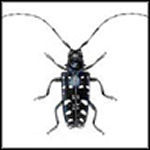
|
Asian Long-horned beetle - Kills deciduous trees - DON'T bring wood home from the cottage! |
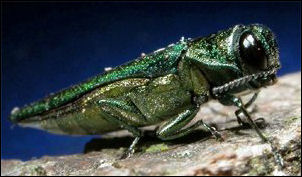
|
Emerald Ash Borer - Kills ash trees |
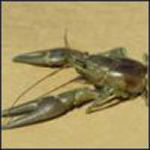
|
Rusty Crayfish - Very aggressive invading species - They are destroying native crayfish colonies. According to the MNR, "Native crayfish are one of the highest at-risk groups among plants and animals with more than half of the species being either vulnerable, imperiled, critically imperiled or presumed/possibly extinct." |
You can view and download the .pdf INVASIVE SPECIES right here.
For more information, you can visit invadingspecies.com, run by the Ontario Federation of Anglers and Hunters.
Report sightings of invasive species online by clicking here.
Asian Carp
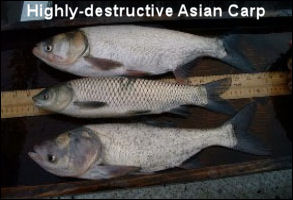 Invasive alien species are one of the largest threats to biodiversity in Ontario. What are they? They are plant and animal species that have been introduced outside of their normal distribution and are able to establish and spread and modify ecosystems, habitats or species. They have been introduced to Ontario through fish stocking, ship ballast water, or the escape of garden plants.
Invasive alien species are one of the largest threats to biodiversity in Ontario. What are they? They are plant and animal species that have been introduced outside of their normal distribution and are able to establish and spread and modify ecosystems, habitats or species. They have been introduced to Ontario through fish stocking, ship ballast water, or the escape of garden plants.
There are often no natural predators for these species, which allows them the opportunity to displace native species. In many cases, their invasion can threaten the environment, economy and human health. Examples of invasive alien species are zebra mussels, Asian carp, Eurasian watermilfoil and buckthorn.
What can you do?
· Inspect your boat, trailer and fishing gear for hitchhikers
· Drain any water from your boat before leaving a waterbody
· Wash and dry your boat, trailer, tackle and equipment before entering another waterbody
· Empty your bait bucket on land - never into the water!
· Report any new findings to 1-800-563-7711 (Invasive Species Hotline)
· Do not plant invasive alien trees, shrubs or perennials (e.g. goutweed, english ivy, periwinkle)
· Write a letter to the Canadian government to urge them to stand up on issues such as the Asian carp invasion. For more information on Asian carp and directions on how to support this effort click here.
WILDFIRES
 A current program spear-headed by FOCA is FIRE SAFETY. With climate change, wildfires are becoming more dangerously common.
A current program spear-headed by FOCA is FIRE SAFETY. With climate change, wildfires are becoming more dangerously common.
The second biggest cause of wildfires in Ontario is cottagers.
Do you know how to burn debris safely? The MNR has thorough directions for safe burning posted here:
Burning Grass and Woody Debris Safely
How safe is your cottage from wildfires? The FireSmart program from FOCA and the MNR offers a self-assessment of your property, as well as crucial information on protecting your structure.
You can download the PDF by clicking here.
(Photo courtesy Ministry of Natural Resources)
LAND MANAGEMENT AND CONSERVATION
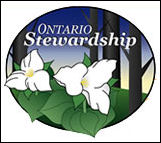 The Ministry of Natural Resources’ Ontario Stewardship program is a community-based initiative that brings together landowners, associations, resource agencies and individuals who share an interest in responsible land care and sustainable resource use. The program advocates stewardship as a tool for land management.
The Ministry of Natural Resources’ Ontario Stewardship program is a community-based initiative that brings together landowners, associations, resource agencies and individuals who share an interest in responsible land care and sustainable resource use. The program advocates stewardship as a tool for land management.
Participants in the program are encouraged to work together to develop an ecosystem-approach for improving local stewardship and to create collaborative resource management tools.
Visit their site at The Ontario Stewardship Councils.